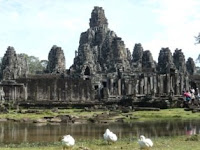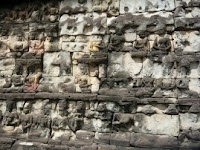The Splendours of Angkor Thom, the Bayons & Ta Prohm Temples
Angkor Thom was built by Cambodia's greatest builder, Jayavarman VII. This 12 sq km city is enclosed by a 8m high wall and encircled by a 100m moat said to have been inhabited by fierce crocodiles. There are five 20m high gates in the wall in each of the North, West and South walls and 2 in the East Wall. Access is via causeways over the moat that are flanked by the statues of 54 Gods on the left and 54 four devils on the right, all seemingly engaged in a game of tug of war.
The moats played a vital role of defense in the ancient time and the walls functioned as defense. The earthen embankments inside serve two functions:
1. they support the walls so that the walls could not be pushed inward
2. they were used for the King’s soldiers to walk on the top to safeguard the city.
There are 5 entrances (gates) to the city, each is decorated with four giant faces in cardinal point which first represent the face of Brahma, one of the three main gods in Hindu religion, second represent the face of Buddha, the face of the king, and also means compassion, sympathy, charity and tolerance that the king had for his people. Angkor Thom was built over an existing city called Yasodharapura of the 10th century.
The Bayon is the major attraction of Angkor Thom. Lying at the centre of Angkor Thom, they were built in the latter part of the 12th century by Jayavarman VII. Bayon is one of the most widely recognised temples in Siem Reap because of the giant stone faces that adorn the towers of Bayon. When you first enter the temple, it seems to be a shapeless mass of grey and brown stone but as you approach the temple, the image of hundreds of carved stone faces become apparent. In addition to the carved stone towers, the highlight of Bayon is the bas reliefs which adorn the walls of galleries around the temple. Each wall has diverse themes depicting scenes of the military procession, sea battle, childbirth, cockfighting, palace and daily life of the locals. Built about 100 years after Angkor Wat, Bayon is now the second most popular site after Angkor Wat and no visit is complete without a trip to see this amazing and unique temple.



Top left: North Gate
Top Middle: East Gate
Top Right: West Gate
Bottom Left: South Gate
Botton Right: Victory Gate

Angkor Thom & the Bayons
The series of colossal human faces curved in stone at the Southern Gate.
On the top terrace of the Bayon you come face-to-face with myriad giant heads topped with lotus crowns. The brownish stone is splotched with moss, lichen, and green fern growth. The giant stone faces of Bayon have become one of the most recognizable images connected to classic Khmer art and architecture. There are 37 standing towers, most but not all sporting four carved faces oriented toward the cardinal points. The best of Bayon are the bas-reliefs on the exterior walls of the lower level and on the upper level where the stone faces reside. The bas-reliefs on the southern wall contain real-life scenes from the historical sea battle between the Khmer and the Cham.
to view and appreciate ...
each and every of these 200 faces with mysterious looks...
and be fascinated by their calmness, their smile, their greatness...





Ta Prohm Temples
The 800-year-old Ta Prohm shrine, better known as temple of trees, was one of the first temples built by the great builder King Jayavarman VII around 1186. It is best known as the temple where trees have been left intertwined with the stonework, much as it was uncovered from the jungle. You may think this temple is in a state of disrepair but there is a strange beauty in the marvelous strangler fig trees which provide a stunning display of the embrace between nature and the human handiwork.
This is one of the most popular temples after Angkor Wat and the Bayon because of the beautiful combinations of wood and stone. The temple deliberately left overgrown with trees to preserve the sense of how the ancient complex of ruins was found in the 1800s. Entered the temple through the east gate and see a long white sandy path between the outer gate and the inner sanctuary, you may recognize a few scenes from Angelina Jolie's Tomb Raider.
While the temple is very popular, most visitors follow a central route and the sides of the complex are surprisingly quiet. Take note that large sections of the temple are unstable rubble and have been cordoned off, as they are in real danger of collapse. Restoration work funded by the government of India began in 2006.



right: this doorway was featured in the Lara Croft Tomb Raiders movie with Angelina Jolie.
Within the ancient city of Angkor Thom holds a number of other sites of interest:
>> The Elephant Terrace
>> The Terrace of the Leper King
Left: Statue of the Leper King
Right: Terrace of the Leper King
>> The Phimeanakas
Located inside the ancient Royal Palace compound, the Phimeanakas served as the king’s temple. The lack of surviving carvings leaves it artistically uninteresting, but it is the tallest scalable temple in Angkor Thom, providing a nice view from the top. The western staircase (right picture), located at the back is the most easily ascended.
>> Phnom Bakheng
It is the first temple-mountain constructed in Angkor, with a commanding hilltop location. It is a popular spot to watch sunset. However, before you enjoy the beautiful sunset, you need to hike at least half an hour to the top. Be careful, the final climb to the top of the temple is steep and dangerous. Even if you pay $15 for an elephant to carry you to the hilltop, you still have to climb the temple stairs on your own. 

A piece of advice: Ascend early to get a good spot to view the sunset. Descend before the sky gets dark. It's good to bring a touchlight with you.






























No comments:
Post a Comment